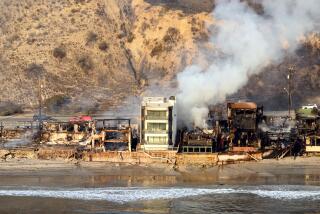Experts Seek to Find Why Some Buildings Fell
- Share via
MEXICO CITY — Architects and engineers roamed the ruined parts of this capital Saturday, trying to find patterns in the earthquake wreckage and lessons to use in putting Mexico City back together.
The task was difficult. Contradictions were everywhere.
For the record:
12:00 a.m. Oct. 10, 1985 For the Record
Los Angeles Times Thursday October 10, 1985 Home Edition Part 1 Page 2 Column 1 Foreign Desk 2 inches; 45 words Type of Material: Correction
The Times mistakenly reported Sept. 22 that Mexico City’s “Hotel General Prim” had “fallen” in the Sept. 19 earthquake there. In fact, the hotel, whose correct name is the Hotel Prim, suffered no major damage and is accepting guests. It was another hotel, just across General Prim Street from the Hotel Prim, that collapsed.
In some sectors, modern steel structures crumpled next door to ancient churches that seemed untouched. In other areas, concrete office buildings and schools were reduced to piles of pulverized debris, while structures beside them, also made of reinforced concrete, stood their ground.
The second earthquake to rattle this congested city in two days, that of Friday evening, compounded problems by raising the number of demolished structures to 290, most of them in the Cuauhtemoc borough, and opening new cracks in others.
Teams of architects and civil engineers under orders from the city government fanned out downtown to inspect all buildings affected by the quakes to see which of them can be allowed to open for business Monday.
Meanwhile, groups of architects and engineers debated on Mexican television whether some buildings had been constructed with substandard materials, or otherwise in violation of building codes, to shave costs. Many of the fallen structures were built by the government.
Mexico City’s municipal government announced an investigation into the collapse of the Neuvo Leon apartments, part of a huge public housing project.
Jack Stevens, an American-born engineer who works for a U.S. firm here, said, “From what I’ve seen, I’m surprised that three-fourths of the town isn’t leveled.”
Snapping photographs of the fallen Hotel General Prim, Stevens said that many sandwiched multi-level hotels might have been saved had they used “braces” of steel on the sidewalls.
His observation seemed to contradict the impression that--because of the country’s building codes, which local architects and engineers describe as among the world’s strictest--most buildings here are as safe as possible.
110 Students Entombed
At the destroyed Conalep Technical School, architects Salvador Mendieta and Fernando Ramirez surveyed the mound of concrete that had entombed up to 110 students.
“It is hard to decide why some buildings fell and others did not,” Mendieta said.
But Mendieta, among others, also offered three commonly heard explanations: Mexico Cityis built on soft clay, making even the strongest structures vulnerable; the quakes produced extremely violent shaking, and much of the building was done before new anti-earthquake technology was developed.
“The main problem was intense, prolonged vibration--when you blow the high note, the glass shatters,” Mendieta said.
One engineer at the huge, collapsed Nuevo Leon apartment building said the area, which is dense with high-rises, sits atop some of the soft soil of Mexico City. Much of this capital rests on an ancient dry lake bed.
Compensating for Soil
Some buildings were constructed to compensate for this.
Carolina Smith, director of sales at the 20-story Sheraton Maria Isabel Hotel, said: “There are actually nine separate buildings in this structure. In an earthquake, these buildings sway with each other.”
Hotel guests, horrified on Friday to watch floors seem to split and move horizontally in opposite directions, could attest to that.
“Many of the buildings that collapsed were of a more solid construction,” Smith added.
The Conalep Technical School was built of reinforced concrete and once stood between a steel structure and another of concrete. It had a special problem, according to an engineer at the scene.
Rafael Jacomed speculated that the adjoining buildings clapped violently against the sides of the school, causing it to topple inward.
Offering Little Comfort
Such explanations were little comfort to grief-stricken people who lost homes, friends and relatives.
“Mexico City is full of old and poorly constructed buildings,” said Jesus Caamano, 46, who awaited word on the fate of his 16-year-old son trapped in the school. “Thousands of people are dead because of it.”
Few officials would go that far.
Surveying the mountainous remains of the collapsed 20-story office tower in which the city’s subway system was operated, engineer Roberto Ocampo acknowledged that “we will have to re-study the materials under which our buildings are constructed.”
“In this case, we have a steel structure that fell forward,” he said. “But we’ve seen forward, backward and sideways.”
Then he added, “It is beyond our scope at this time to decide why it happened this way.”
Cathedral Is Unscathed
A block away, in the same eastern end of the city, the brick and mortar Cathedral of San Miguel was unscathed. The structure is more than 150 years old, and its polished saints sturdily maintain their ancient watch from wood and marble pedestals.
“The churches have very heavy foundations,” Ocampo said, “and their walls are very thick.”
Experts interviewed on television also noted that the churches were survivors of old quakes that had destroyed many other buildings.
While few, if any, of the hundreds of churches in Mexico City sustained serious damage, other structures were less fortunate.
More to Read
Sign up for Essential California
The most important California stories and recommendations in your inbox every morning.
You may occasionally receive promotional content from the Los Angeles Times.














